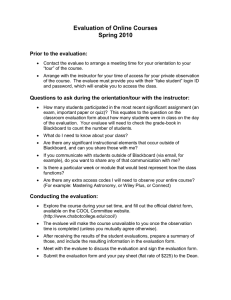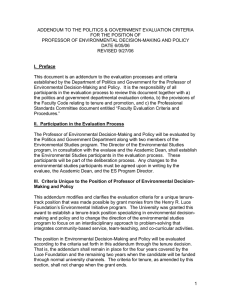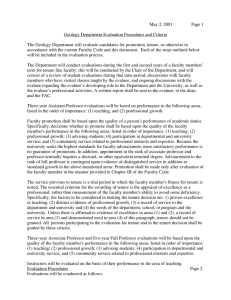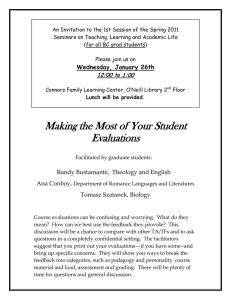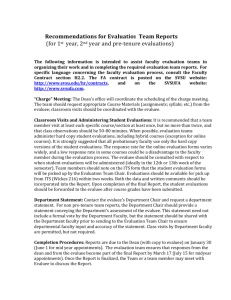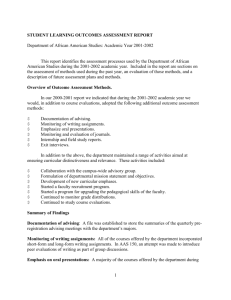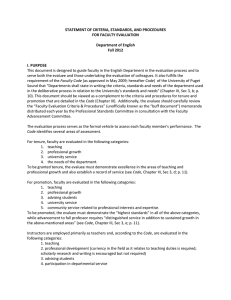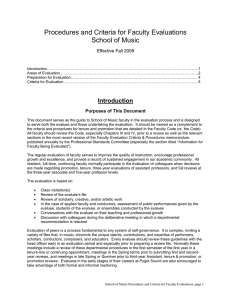DEPARTMENT OF ART AND ART HISTORY STATEMENT OF PROCEDURE FOR
advertisement
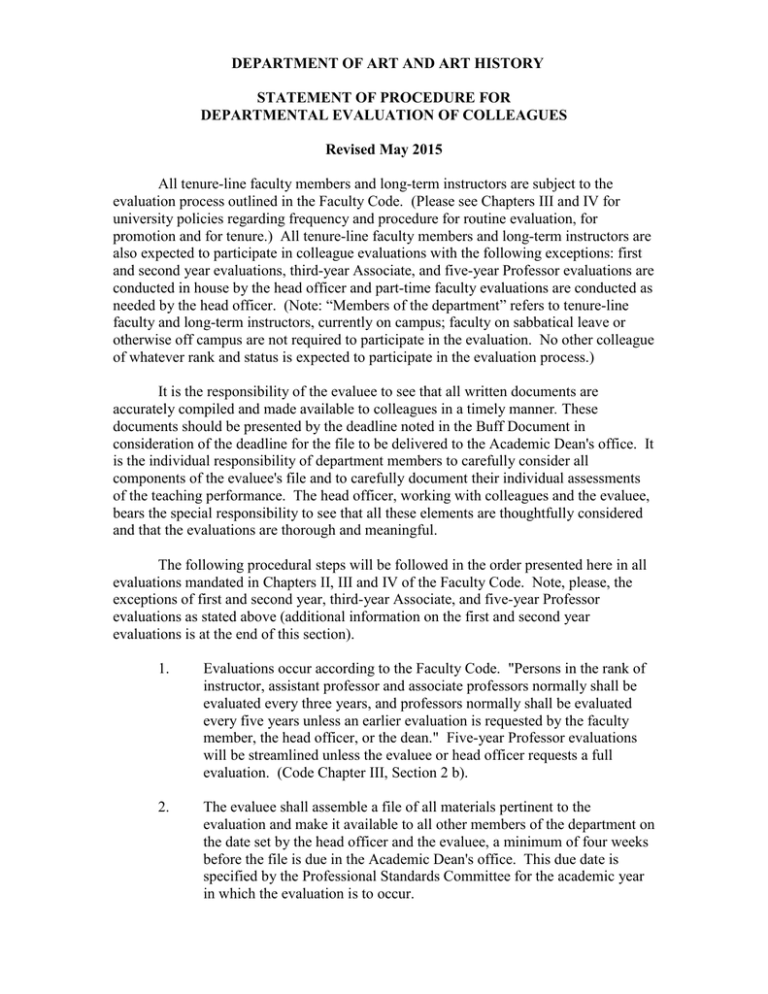
DEPARTMENT OF ART AND ART HISTORY STATEMENT OF PROCEDURE FOR DEPARTMENTAL EVALUATION OF COLLEAGUES Revised May 2015 All tenure-line faculty members and long-term instructors are subject to the evaluation process outlined in the Faculty Code. (Please see Chapters III and IV for university policies regarding frequency and procedure for routine evaluation, for promotion and for tenure.) All tenure-line faculty members and long-term instructors are also expected to participate in colleague evaluations with the following exceptions: first and second year evaluations, third-year Associate, and five-year Professor evaluations are conducted in house by the head officer and part-time faculty evaluations are conducted as needed by the head officer. (Note: “Members of the department” refers to tenure-line faculty and long-term instructors, currently on campus; faculty on sabbatical leave or otherwise off campus are not required to participate in the evaluation. No other colleague of whatever rank and status is expected to participate in the evaluation process.) It is the responsibility of the evaluee to see that all written documents are accurately compiled and made available to colleagues in a timely manner. These documents should be presented by the deadline noted in the Buff Document in consideration of the deadline for the file to be delivered to the Academic Dean's office. It is the individual responsibility of department members to carefully consider all components of the evaluee's file and to carefully document their individual assessments of the teaching performance. The head officer, working with colleagues and the evaluee, bears the special responsibility to see that all these elements are thoughtfully considered and that the evaluations are thorough and meaningful. The following procedural steps will be followed in the order presented here in all evaluations mandated in Chapters II, III and IV of the Faculty Code. Note, please, the exceptions of first and second year, third-year Associate, and five-year Professor evaluations as stated above (additional information on the first and second year evaluations is at the end of this section). 1. Evaluations occur according to the Faculty Code. "Persons in the rank of instructor, assistant professor and associate professors normally shall be evaluated every three years, and professors normally shall be evaluated every five years unless an earlier evaluation is requested by the faculty member, the head officer, or the dean." Five-year Professor evaluations will be streamlined unless the evaluee or head officer requests a full evaluation. (Code Chapter III, Section 2 b). 2. The evaluee shall assemble a file of all materials pertinent to the evaluation and make it available to all other members of the department on the date set by the head officer and the evaluee, a minimum of four weeks before the file is due in the Academic Dean's office. This due date is specified by the Professional Standards Committee for the academic year in which the evaluation is to occur. The file must contain documents addressing all items identified in the Faculty Code: Chapter III, Sec. 4 a (1) (a), the evaluee’s copies of the preceding two semesters of student evaluations (4 semesters in tenure evaluations), and other pertinent documents related to the evaluation categories of the Code (identified above). The evaluee's statement should include information on his or her professional and pedagogical goals and objectives. It should include information on teaching, professional growth, advising, university service, and community service. 3. Each tenure-line member of the department who is not on leave should visit a minimum of two of the evaluee’s classes during the semester of evaluation or during the two semesters before the evaluation is conducted. Preferably, these visits should be consecutive classes. This is the expected pattern for art history and studio visitation. In cases of leaves or sabbaticals and conflicts of class schedules, members of the department may need to visit classes during the semester preceding the leave or sabbatical. 4. Each member of the department shall forward his/her individual written evaluation to the head officer. 5. At a date following the completion and delivery to the head officer of individual letters from department faculty, members of the department will meet with the evaluee. This is an opportunity for the evaluee to elaborate on or clarify items in the file; it also provides colleagues an opportunity to seek clarification of information within the file. After any requested clarification has been provided, the evaluee leaves the meeting and members of the department will discuss and decide whether or not the evaluee has met the department and university requirements for the particular evaluation in question. At this point members of the department may submit an addendum to their original letter. Following this meeting and the submission of any addenda, the head officer shall prepare a department summary letter and a recommendation for the Academic Dean and Faculty Advancement Committee. 6. The head officer will provide the faculty member with a list of department members participating in the deliberations, a summary of the department's deliberations, and the department recommendation. If the file is closed the head officer will also provide the evaluee with a summary of the substance of the letters and addenda and a list of those who submitted letters to the head officer. In addition, the head officer will also provide to the evaluee a summary of the substance of the information included in outside letters that are sent to the head officer and a list of the names of the letter writers. 7. The departmental summary letter shall be signed by members of the department. Any department member who disagrees with the departmental recommendation may submit an addendum letter stating reasons for this minority view. Since such letter has been generated 2 through the departmental process of evaluation, it must be submitted to the FAC by the review’s head officer. (See Code, Chap. III, Sec. 4.b (1) and (2).) 8. Letters from outside the department must be received at least ten days prior to the deadline for submission of the completed file to the Academic Dean. Therefore, the final departmental deliberation must take place after the deadline for submission of outside letters. All materials used in the evaluation process by the department, including all letters from individuals and the department summary letter, shall be forwarded to the Faculty Advancement Committee. When a member of the department is being evaluated during the first or second year of employment, the head officer conducts the evaluation utilizing student evaluations, class visits and/or conferences with the evaluee. The head officer will prepare a written evaluation and forward it to the evaluee concerned. A copy of the departmental evaluation will be sent to the Academic Dean. STANDARDS AND CRITERIA FOR EVALUATIONS DEPARTMENT OF ART AND ART HISTORY STANDARDS FOR TEACHING Teaching is an important criterion for evaluation. While "teaching" is primarily a classroom enterprise, its range extends well beyond the classroom. The quality and currency of syllabi, course conceptualization and attention to pedagogical effectiveness are appropriate considerations in the evaluation of a colleague's teaching ability. No one style, strategy or philosophy of teaching should be favored; rather the effectiveness of the teacher in relation to the subject matter and the application of his or her particular skills must be the primary issues. The evaluation of teaching should rest on direct experience of class visitation, study of the course materials, analysis of the student evaluation forms, and on judgments drawn from disciplinary expertise. In the evaluation process, departmental colleagues should attempt to use the forms of evidence listed here to address the major components of effective teaching. The department should also recognize the contributions of a faculty member to the general university teaching program as a whole: e.g., participation in other programs and to the core curriculum. These same factors should be addressed by evaluees in their self analysis. COMPONENTS OF EFFECTIVE TEACHING 1. Course Construction A. Content Course content should be consistent with the role of the course within the department and the university. 3 B. Learning Outcomes Learning outcomes should be clearly identified. C. Rigor Texts, readings, writing assignments, exams, and projects should clearly lead to the development of the course objectives, and should reflect an appropriate level of expectations consistent with the general standards established by other courses of the same nature within the department. These materials and assignments should be selected to maximize the student mastery and understanding of the course content. D. Currency The evaluee should demonstrate knowledge and expertise in the fields of his/her instruction 2. Pedagogy A. Effective communication Professors should communicate ideas and concepts clearly and monitor student understanding effectively. Professors should solicit student questions and respond appropriately. B. Feedback Professors should provide timely and appropriate feedback to students regarding their performance on exams and assignments. C. Engagement Professors should use appropriate and effective methods to engage students, to encourage them to understand and master course content. D. New Courses Professors should develop new courses and/or revise established courses to include new techniques and relevant approaches (studio courses) and information or new interpretations of historical works (art history). E. Availability Professors should establish office hours and be available, within reason, by appointment for students whose schedules conflict with posted office hours. 3. Evidence of Effective Teaching A. The evaluators should base their assessment of teaching on direct observation of classroom performance. For both art history and studio, each tenure-line member of the department who is not on leave should visit a minimum of two of the evaluee’s classes during the semester of evaluation or during the two semesters before the evaluation is conducted. If possible, it is desirable for at least two members of the department to make two consecutive classroom 4 visits. This pattern should provide the evaluator with some evidence of consistency of presentation, development of ideas, issues and the level of teacher/student interaction. For studio faculty, the appropriate class sessions for observations are demonstrations or critique periods. B. The evaluators should base their assessment of teaching on thorough examination of course materials, including syllabi, examinations and assignments. C. The evaluators should base their assessment of teaching on thorough examination of all available student evaluations. DEPARTMENT OF ART AND ART HISTORY STANDARDS FOR PROFESSIONAL GROWTH AND DEVELOPMENT The Department of Art and Art History places a high value on professional growth. The sense of a sustained professional engagement may be expressed by the word "vitality.” This means that faculty members must remain current in their discipline. The pursuit of research and creation of art works are essential activities that inform our roles as teachers and professors and as role models who demonstrate lifelong learning. The curricular needs in both studio and in art history require that the department be composed of members whose formal training is dissimilar; therefore individuals will have widely differing areas of expertise. There are some general expectations of all tenure track members regardless of disciplinary training. They are: (1) maintaining currency in one's field, and (2) participation in the wider field of art beyond the classroom and the campus. Because the department is composed of artists and art historians, required activities used to evaluate faculty may differ. The department has constructed a list of activities in each of these areas that constitutes acceptable forms of professional growth. Items numbered 1 and 2 on each list are expected professional activities. Recognition will be given for engagement in the subsequent list of activities (in the case of studio art numbers 3-7, in the case of art history numbers 3-6). Items 3-7 for studio art and 3-6 for art history are not prioritized, nor is it expected that one will participate in all activities listed. In order to meet the department's standards for quality in professional growth, the evaluee must demonstrate that he or she has been actively engaged in activities outlined below, and that the level of effort and quality of results are significant. STUDIO 1. The faculty member will be actively engaged in the regular production and exhibition of artwork. This may include, but is not limited to, presentation of work in group and solo exhibitions, symposia, portfolio sessions, public spaces, and other formats. The department recognizes that a one or two person show 5 generally carries more weight than a single art work in a group exhibition, although each is important and should be judged on the caliber of the exhibition and on the perceived quality of the exhibited work. 2. The faculty member will present evidence in the classroom of an awareness of current techniques and developments in his/her teaching areas. Such awareness may be evidenced by participation in seminars, workshops and professional meetings, residencies, and independent research, which present recent developments in studio areas of the individual's concern. 3. Recognition will be given to faculty whose work is included in public and/or private collections. 4. Recognition will be given to faculty invited by other institutions to participate in colloquia, workshops, graduate and undergraduate critiques, and/or to lecture. 5. Recognition will be given for service to professional organizations in the faculty member's field of expertise, including officer's duty, panel facilitator or other significant organizational duties. 6. Recognition will be given to the faculty member whose work, reviews, or articles appear in regional or national art publications. 7. Recognition will be given to the faculty member who participates in curatorial projects and/or the publication of exhibition catalogs. ART HISTORY 1. The faculty member will engage in independent and/or collaborative research that results in, or is expected to result in, publication. 2. The faculty member will engage in presentation of papers, participation in panels at local, regional, national, and international conferences. 3. The faculty member should, when possible, attend lectures, seminars or colloquia which provide otherwise inaccessible information related to his/her field. 4. Recognition will be given to those faculty members who are invited by other institutions to participate in colloquia, workshops, and/or to lecture. 5. Recognition will be given for service to professional organizations in the faculty member's field of expertise, including officer's duty, panel facilitator or other significant organizational duties. 6. Recognition will be given to the faculty member who participates in curatorial projects and/or the publication of exhibition catalogs. DEPARTMENT OF ART AND ART HISTORY STANDARDS FOR ADVISING 6 Advising is critical to the educational mission of the university. Thus, department members must take seriously their responsibilities to their students and to the university. Advising techniques differ from individual to individual and differ too from student to student. However, common elements of each advising situation must include knowledge, desire to advise and availability to do so. KNOWLEDGE Advisors must have a good working knowledge of the university's departments and curricula and its rules and regulations; a familiarity with the student support services in order to make referrals; and a sufficient knowledge of each advisee's capabilities in order to guide the selections of courses and programs of study. Advisors should maintain their advisee's academic record (advising file) with sufficient thoroughness that should leaves or sabbaticals occur, another colleague may, without difficulty, discern the planned academic program. The advisor is encouraged to make use of the academic program guides and any other material provided to the advisor by the Office of Academic Advising. AVAILABILITY Advisers must be available to students at reasonable times, through office hours, appointments and, if possible, for the unexpected encounters after class or on other parts of the campus. Effective advisers often counsel students who are not their advisees. Moreover, advisors must demonstrate a genuine willingness, openness, and desire to assist students in planning their academic programs and should be willing to offer career related advice. They should be alert to the occasion of serious problems and take quick action to direct students to the appropriate office for help if necessary. Tenure-track faculty are not assigned advisees until their second year of service. EVIDENCE OF EFFECTIVE ADVISING It is the responsibility of colleagues undergoing evaluation to demonstrate an awareness of the components of effective advising and to offer an accurate description and assessment of his/her advising activities in a self-evaluation statement. Evidence of advising activities should include the following: 1. A regular office hour schedule 2. Taking a fair share in the number of advisees who are art majors or who are assigned to the art department 3. All members in the department are encouraged to teach advising sections whenever possible. 7 DEPARTMENT OF ART AND ART HISTORY STANDARDS FOR DEPARTMENTAL, UNIVERSITY, AND COMMUNITY SERVICE It is expected that each faculty member will be involved in both departmental governance and in the broader, democratic governance opportunities of the university. There are many ways to contribute to the service needs of the university. What follows is a partial list. This list should be treated as a guideline since the department recognizes that the extent and manner of service will depend on individual talents and interests. DEPARTMENT SERVICE Department service can cover a wide range of activities. Although not everyone will participate in all service activities in a given review period, forms of service include: 1. Serving as department chair 2. Participation in evaluation of department colleagues 3. Participation in recruiting and hiring 4. Attendance and participation in department meetings 5. Participation in drafting statements on department policies and procedures 6. Participation in drafting department statements for accreditation reports and five-year reviews 7. Acting as department representative The Department of Art and Art History faculty members recognize that our work cannot be undertaken without equipment and spaces specific to each discipline within the department. Therefore the following are essential for each area: 1. Maintenance of instructional equipment and supplies, and work spaces in art studios (only applicable to art studio faculty) 2. Maintenance of instructional equipment and supplies for the teaching of art history (only applicable to art history faculty) 3. Attending to the development of library resources (both art studio and history faculty) UNIVERSITY SERVICE University service includes all campus activities outside the department. Apart from the obvious areas of service; i.e., membership on standing committees, participation in co-curricular activities and attendance at general faculty meetings, the department attempts no listing of possible roles. An individual's talents may provide unique opportunities for service. Tenure-line faculty are generally excused from university committee assignments during their first year. COMMUNITY SERVICE Community service related to professional interest and expertise is required. 8
